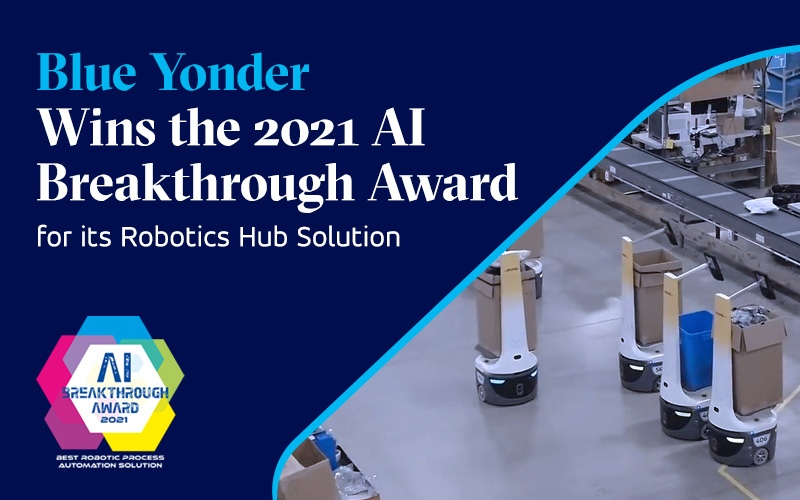Leading logistics teams are leveraging robotics, collaborative robots (cobots), drones, and a variety of automation tools such as picking bots to complement their human capabilities. These teams are also adding artificial intelligence (AI), machine learning (ML), smart machines, and IoT solutions to their digital toolboxes to support more intelligent, more responsive operations1.
According to the 2021 Logistics Executive Survey, conducted by Blue Yonder earlier this year, to meet growing demands while reducing costs, nearly 42% of logistics executives plan to implement AI and/or ML and nearly half (48%) plan to implement and/or enhance their warehouse management systems (WMS) and cloud infrastructure in the next 12 months2.
By 2025, according to ABI Research3, over 4 million commercial robots will be installed in over 50,000 warehouses, up from just under 4,000 robotic warehouses in 2018. But, combining these technologies into successful initiatives and getting them to work with existing systems are forming challenges for many organizations. For example, on-boarding robots requires highly complex, customized integrations. This may cause disparate views for operations managers to handle, leading to islands of automation within the same warehouse or distribution center (DC). Maintenance and upgrades may also be expensive.
An Award-Winning Robotics Solution
To assist warehouse operations in achieving this vision and to tackle the on-boarding challenges, Blue Yonder developed its Robotics Hub solution together with its long-time customer DHL Supply Chain and its strategic partner Microsoft.
The solution was selected as the winner of “Best Robotic Process Automation Solution” in the fourth annual AI Breakthrough Awards program4, conducted by AI Breakthrough, a leading market intelligence organization that recognizes the top companies, technologies and products in the global Artificial Intelligence (AI) market today.
At a time when fulfillment solutions have never been more important, the Robotics Hub helps improve visibility across different automation solutions. It is now easy to integrate new robots into existing platforms and connect to their customers’ various warehouse management systems (WMS).
According to James Johnson, AI Breakthrough’s managing director, “Organizations are challenged as different robot vendors manage their own robots, causing different views for operations managers to handle leading to islands of automation within the same warehouse.”
Important Elements
Robotics Hub:
- Augments the shrinking workforce with robotics.
- Increases speed to value by reducing the onboarding process and achieve a faster ROI.
- Gains insights about your operations across multiple robotics vendors from a single dashboard.
- Offers organizations the ability to onboard multiple robotics vendors with different capabilities, increasing operational flexibility and avoiding getting tied down to one vendor.
- Gains out of the box AI and ML capabilities to improve efficiency.
The solution implements standard workflows and application programming interfaces (APIs) that can be re-used across different automation solutions. An API is a software intermediary that allows two applications to communicate with each other. Robotics Hub on one side connects with WMS and on the other with different robotics and automation providers through a standard set of RESTful APIs. The technology leveraged here (RESTful APIs) was mainly for performance/bandwidth reasons and is the same technology Amazon, Google, LinkedIn, and Twitter use for their websites.
Innovation Comes to Life with DHL
DHL’s Accelerated Digitalization Initiative aims to rapidly establish its technology leadership. A key goal of the initiative is to incorporate automation and robotics at more than 2,000 sites, orchestrating this implementation from a global perspective.
However, a critical factor to accomplishing this was a solution that would be compatible with DHL’s existing Blue Yonder WMS and allow multiple robotics vendors to integrate easily. From an initial conversation between DHL Supply Chain and Blue Yonder in October 2019, the idea for Robotics Hub was born.
Built on Blue Yonder’s Luminate Platform, which is powered by Microsoft Azure, the SaaS-native application was first implemented in a DHL warehouse in Madrid, Spain, going live in May 2020. This first implementation resulted in a 60% reduction in implementation time for robotics, resulting in faster delivery of ROI in the first six months. DHL is rolling out the solution at more sites this year. With subsequent deployments, DHL foresees further improvements of up to 90%.
This video highlights the successful, first implementation.
An Emerging Trend
Humans and machines are learning to work together in seamless, fluid ways, where the best resource is chosen for the task at hand, in real-time, as conditions change. Smart orchestration engines continuously monitor new orders and other changes, then apply constraints such as asset availability, human skillsets, employee availability, and equipment capacity. These engines autonomously deliver an optimized work plan with detailed tasks, such as pick lists, that will support on-time, in-full deliveries. Orchestration engines also leverage ML, digitized warehouse maps, travel paths, and labor standards to fine-tune the effort for each work item.
Through dynamic resource adjustment the engines can autonomously update the plan in a way that optimizes the balance between customer service and financial impacts. The results also include improved accuracy, productivity, and agility in warehouses and other facilities.
Learn more about the Robotics Hub and the topic of human and machine through the Future of Logistics eBook. For more information about the AI Breakthrough Award, please review this press release.
1 “Future of Logistics eBook”, by Blue Yonder
2 “Insights from the 2021 Logistics Executive Survey: The New Normal of Logistics”, by Terence Leung, Blue Yonder
3 “Robotics in E-Commerce Fulfillment”, ABI Research
4 The mission of the AI Breakthrough Awards is to honor excellence and recognize the innovation, hard work and success in a range of AI and machine learning related categories, including AI platforms, Deep Learning, Smart Robotics, Business Intelligence, Natural Language Processing, industry specific AI applications and many more. This year’s program attracted more than 2,850 nominations from over 17 different countries throughout the world.

